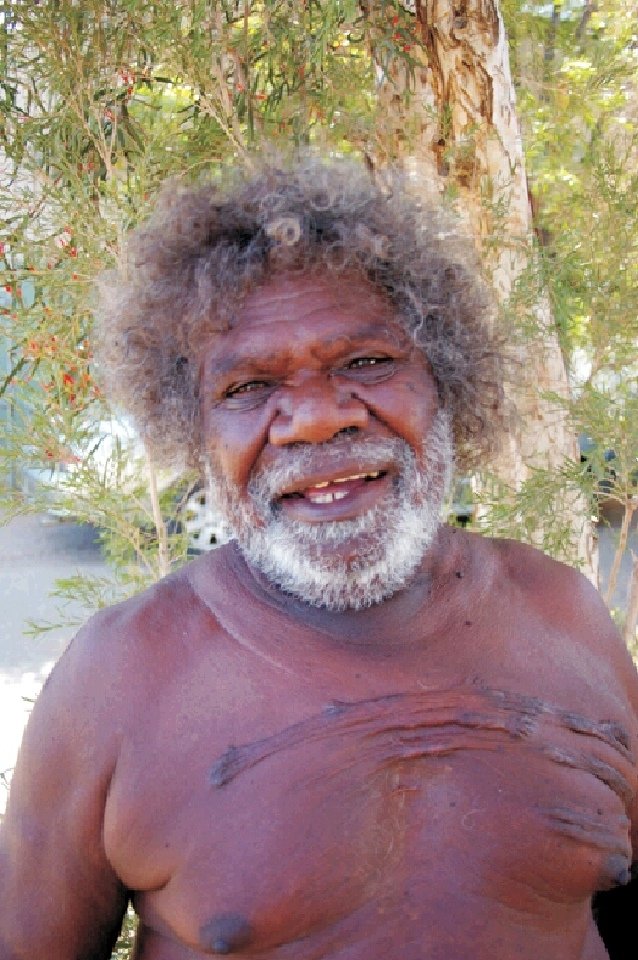GEORGE (HAIRBRUSH) TJUNGURRAYI
MARKET ANALYSIS

Photo: Kate Owen Gallery
George Tjungurrayi’s works first appeared at auction in 1995, the year that Yatintjanga 1978, painted just 2 years after he took up the brush, was offered for sale. The 125 x 162 cm, canvas was a fine example of Pintupi Tingari paintings of the period featuring interconnected sites in very pleasing earth tones. It was estimated at $10,000-15,000 and sold at Sotheby's for just $11,500 (Lot 615) yet this is still the highest price ever achieved for an early career work and currently the 14th highest result his paintings have achieved at auction.
By the end of 2001, 12 works had been offered of which 10 had sold. However, despite a clearance rate of 83%, his average price at that time was a paltry $2,846. It was not until 2002 that a work achieved a price anywhere near those commanded by his better works in the primary market. In June that year Sotheby’s sold Mamultjulkulnga 1998 a painting that measured 152 x 181.5 cm. for $26,840 (Lot 44). This painting currently occupies the artist’s 9th best record. It was transcended the following year when a similarly sized work, Paykapungkunya 1997, sold for $35,750 now the artists 4th highest result.
Over the following years very few major paintings failed to sell until 2008, a year which saw only 6 of the 22 works offered, find new homes, thereby dropping his career success rate dramatically from 63% to 54%. Yet 2008 also saw 2 works enter his top 10 at 2nd and 8th position. His record price had been achieved the previous year for a work depicting the claypan site of Mamultjulkulnga near Lake McKay created in 2001. The large Papunya Tula provenanced piece, in which the finest of line work was meticulously layered to achieve the final glowing terracotta tones, justified its $50,000-$70,000 estimate by achieving the midpoint at Sotheby’s November sale (Lot 57).
While few, if any resales of George Tjunurrayi’s works have appeared at sale and only 5 major works have failed to sell, his clearance rate has been adversely affected by the large number minor paintings that have been offered. However collectors should be aware that despite considerable success on the secondary market the 5 works that failed to sell all carried excellent provenance and very reasonable presale estimates. As would be expected Sotheby’s have taken up the running on works by this artist having recorded 18 sales at an average price of $18,934 while Lawson~Menzies have sold 10 averaging $11,360. The only other auction houses to represent Tjungurrayi in any quantity have been Joel Fine Art, Shapiro Auctioneers and Christies of which the latter has been the least successful with 5 sales recorded for an average price of just $3,562. There is no doubt that the works created by George Tjungurrayi for Papunya Tula are favoured in the secondary market with these occupying 8 of his top 10 and 14 of his top 20 results. However this may simply reflect the relative numbers of works he has created for the company compared to those he has painted for independent dealers.
By far the largest paintings that have been offered for sale at auction were created for independent dealer Peter Van Groessen and these were originally offered in the primary market through Kimberley Art Gallery in Melbourne. Yam Dreaming and My Father’s Country were both created in 1999 and measured approximately 180 x 350 cm. When offered through Lawson~Menzies in June 2007 and May 2006 they sold for $43,200 and $32,400 the artist’s current 3rd and 6th highest results.
George Tjungurrayi only began painting in 1976 it is not surprising that no works on board have appeared, however it does seem unusual that hardly any 1980’s paintings have been offered. The highest price paid for one of these was for an unremarkable stiff and formulaic work entitled Wirrulnya 1988. Offered at Sotheby’s in November 2007 the 182 x 121 cm. painting carried an estimate of just $7,000-10,000 and, despite its Papunya Tula provenance, sold for just $8,400.
Overall, despite a dramatic fall in his clearance rate during 2008 that prevented his AAMI growing by any more than 14% works by George Tjungurrayi created after the mid 1990’s would appear to be set to continue their rise in value. With a relatively low record price of $60,000 and only 6 works having sold for more than $30,000 it would appear to be a propitious time for collectors to look at his work more seriously. Other seminal artists who took Pintupi men’s art in to its new paradigm in the later part of their career including Turkey Tolson, and Mick Namarari, have record prices of $180,000, $210,000 respectively for works created in the mid 1990’s. George is still alive and actively working however, and hopefully, he has many productive years ahead of him. Because of this I would expect his prices in the primary market to exceed those for all but the very finest that appear at auction for some time in to the foreseeable future. This should create a good opportunity for those collectors, who may not be able to accommodate the largest of his works, to pick up something good at a far more reasonable price at auction than they would pay at one of the galleries, which are contractually tied to Papunya Tula. If Tjungurrayi continues to intermittently paint outside of the company there may be many fine works that buyers, who care less about provenance as a political issue, may be able to purchase for less than the premium that Papunya Tula works attract.

